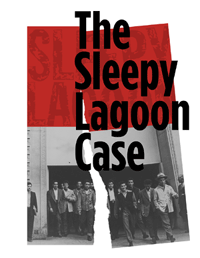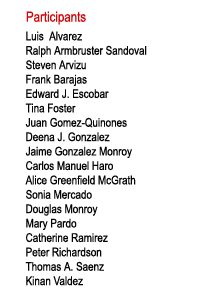



| |
|||
| About the Sleepy Lagoon Case
On August 2, 1942, a young Mexican national named José Diaz was found dead near a reservoir nicknamed the “Sleepy Lagoon.” Local media outlets, most notably the Hearst-owned Los Angeles Evening Herald and Express and the Los Angeles Times, blamed Diaz’s death on a “crime wave” led by Mexican American “zoot-suiters” or “pachucas/os.” More than six hundred youth, mostly Mexican Americans, were arrested, many based on nothing more than their clothes or general appearance. Thus, the existing atmosphere of wartime fear and suspicion took on the added aspect of anti-Mexican racism. Renowned writer, lawyer, and civil rights advocate Carey McWilliams identified the connection between World War II, the Japanese-American internment, and this anti-Mexican backlash: “In Los Angeles, where fantasy is a way of life, it was a foregone conclusion that Mexicans would be substituted as the major scapegoat group once the Japanese were removed.” (North from Mexico, p. 227). Twenty-two youths were indicted in the Diaz case; seventeen were tried in a mass trial, the largest in California history, and the remaining five were tried individually. The trial began in October 1942 with an all-white jury and only seven judges for the seventeen defendants. Three defendants were convicted of first-degree murder and sentenced to life in prison, nine were convicted of second-degree murder and sentenced to five years to life, and five were convicted of assault and released for time served. The five who were tried individually were acquitted. The twelve convicted of first- or second-degree murder began serving their sentences in January 1943 at San Quentin Prison. During the trial, labor activist La Rue McCormick had established an ad-hoc committee to publicize the events surrounding the case. The mainstream media’s coverage was predictably sensationalistic and inflammatory, while the alternative media, including the left, labor, Jewish, Mexican, and African American presses, covered the trial and ensuing events from a perspective more favorable to the defendants. After the defendants were sentenced, the committee was reorganized as the Sleepy Lagoon Defense Committee (SLDC), with Carey McWilliams as its chair. Support for the SLDC came primarily from organized labor and political social justice advocates as well as from the defendants’ family members and prominent members of the film industry. Aided by the SLDC’s fundraising efforts, a team headed by lead appellate attorney Ben Margolis, Jr. launched an appeal in the Second District Court of Appeal (66 Cal Ap 2nd 166) on the grounds of denial of constitutional rights, misconduct by the judge, and insufficient evidence. In October 1944, the appellate justices voted unanimously to overturn the verdicts and set aside the sentences. The twelve were released, having spent almost two years in jail and prison. |
|
|
|
Chicano Studies Research Center | UCLA Special Collections | Fowler Museum of Cultural History | UCLA Library | UCLA Home
© 2005 by the Regents of the University of California. All rights reserved.
 hat
became the Sleepy Lagoon case grew out of an atmosphere of wartime
anxiety and hysteria, much like the U.S. has experienced in the
wake of the September 11 attacks. It began in February 1942, following
the Japanese attack on Pearl Harbor, with the internment of 120,000
Japanese-Americans, two-thirds of whom were United States citizens.
hat
became the Sleepy Lagoon case grew out of an atmosphere of wartime
anxiety and hysteria, much like the U.S. has experienced in the
wake of the September 11 attacks. It began in February 1942, following
the Japanese attack on Pearl Harbor, with the internment of 120,000
Japanese-Americans, two-thirds of whom were United States citizens.